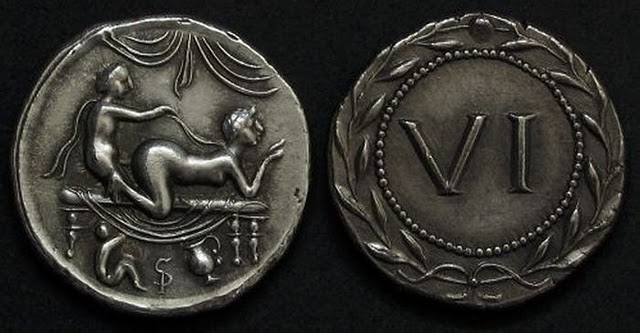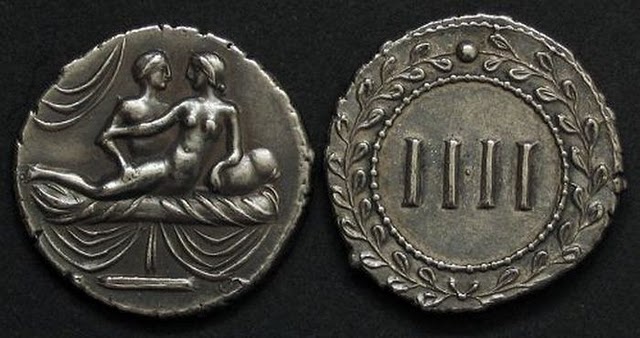 Spintria (plural, spintriae) is a small bronze or brass Roman token, used in brothels, usually depicting sexual acts or symbols along with roman numericals on flipside. According to Suetonius (a Roman historian of 2nd century AD), carrying a ring or a coin bearing the emperor’s image into a latrine or brothel could be the basis for an accusation of treason (maiestas) under Tiberius. Under Caracalla (a Roman emperor of Punic and Syrian descent in 3rd century AD), an equestrian was sentenced to death for bringing a coin with the emperor’s likeness into a brothel. He was spared only by the emperor’s own death later. They were produced only for a short period in Roman History and few argue that they were used as game pieces. These coins were made from brass or bronze, and were little smaller size than a U.S. quarter. The represented erotic act on coin was meant for the provided services. Some of the coins depicted homosexual acts between men.
Spintria (plural, spintriae) is a small bronze or brass Roman token, used in brothels, usually depicting sexual acts or symbols along with roman numericals on flipside. According to Suetonius (a Roman historian of 2nd century AD), carrying a ring or a coin bearing the emperor’s image into a latrine or brothel could be the basis for an accusation of treason (maiestas) under Tiberius. Under Caracalla (a Roman emperor of Punic and Syrian descent in 3rd century AD), an equestrian was sentenced to death for bringing a coin with the emperor’s likeness into a brothel. He was spared only by the emperor’s own death later. They were produced only for a short period in Roman History and few argue that they were used as game pieces. These coins were made from brass or bronze, and were little smaller size than a U.S. quarter. The represented erotic act on coin was meant for the provided services. Some of the coins depicted homosexual acts between men.









They have been minted somewhere between the years 22 and 37 AD, during the reign of the emperor Tiberius or even earlier. Typical rates for prostitutes at the time were somewhere in the range of two to ten asses (basic unit of Roman currency was called the as), which lines up fairly well with the 1-to-16 range imprinted on the coins. In few coins, VIIII was the older style actually used by the ancient Romans. The subtractive style, e.g. “IX” was only used after the Middle Ages.
